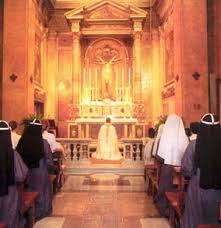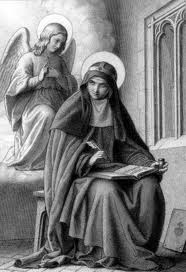.. THE LATIN TRADITIONAL BRIGITTINE DIVINE OFFICE
INDEX
- INTRODUCTION TO THE LATIN TRADITIONAL BRIGITTINE DIVINE OFFICE

- INTRODUCTION TO THE LATIN TRADITIONAL BRIGITTINE DIVINE OFFICE
Introduction.
Given the central place of liturgical prayer in the Brigittine way of life, the starting point for understanding the Brigittine spirituality is studying the composition and contents of the original Brigittine Divine Office. These remarks explain the text of the traditional Brigittine Breviary in use by Syon Abbey until the late 60-es and which is in current use by the Brigittini Servitores Sanctissimi Salvatoris Institute.
Nature.
As far as its theme goes, the Brigittine Divine Office is similar to the Little Office of Our Lady, where the focus is on honouring Our Lady. However, structurally, it is a fuller, more developed version, more closely resembling the traditional Latin Divine Office, also termed the Roman Divine Office.
The fulcrum of the Brigittine Divine Office consists of the Angelic Discourse, divided into 21 portions. These 21 lessons are allocated to the 7 days of the week, three lessons apiece per day For each day. These readings define the theme of the day and are garlanded by the other parts of the Divine Office. The hymns are different for each day for all the Hours. The text of the hymns demonstrates a clear coherence with the lessons of the day.
History of origin.
The text of the Angelic Discourse is based on revelations to Saint Brigitta. The revelations were communicated to her by an angel. Every morning after she has recited her prayers, Saint Birgitta sat at her desk in Rome, from which she could see the high altar of the Church of Saint Lorenzo in Damasco. With paper, pen and ink prepared she waited until the angel came, who dictated her the text of the lessons. Saint Birgitta then turned it over to her spiritual Father. There were days when the angel did not come; on those days, Saint Birgitta told her spiritual director that she had nothing to present. (Ref. Helen M.D. Redpath God’s Ambassadress Bruce Publishing Company, Milwaukee, MN USA 1947 page 71. )

History of use.
Proximity of the Brigittine Brothers to the Sisters in the double monasteries made a double Divine Office possible. The men recited or chanted the regular Divine of the diocese. The Sisters were present during it. At the conclusion of each Hour, the Sisters proceeded with the chanting or recitation of the Brigittine Divine Office. Adding to the regular Divine Office the Brigittine Office with its Marian orientation, it fleshed the Office out, putting it under Our Lady’s mantle, so to speak.
The original pattern of double Divine Office after the disappearance of Brigittine male branches could not be continued.. In the wake of the Council of Trent some communities switched to the use of the Roman Divine Office.
The use of the traditional Latin Brigittine Office survived (or rather, resurfaced again) in England until the latter part of the 20th century. During their exile from England, the Brigittine Sisters of Syon Abbey of England started using the Roman Divine Office. The community returned to England in 1861. In 1906 with the approval of the Bishop of Plymouth, Syon Abbey returned to the use of the original Brigittine Office and continued using it until the post-Vatican II liturgical reforms.

Brigittine Sisters of Syon Abbey, England, early 20th century
By the 70-es all Brigittine communities were using the vernacular and either the updated, shortened and simplified Divine Office, commonly referred to as the “Liturgy of the Hours” or an updated an shortened version of the Brigittine Divine Office in the vernacular.
Use of Latin Traditional Brigittine Office by the Brigittini Servitores Sanctissimi Salvatoris Institute.
At present, parts of the original Brigittine Office in Latin is still in use by the Brigittini Servitores Sanctissimi Salvatoris. In addition to the recitation of the traditional Latin Roman Divine Office in full, we also recite the Brigittine propers (parts other than the psalms) to the all 8 Hours of the Roman Office. This became possible because the availability of the texts of the traditional Brigittine Office through the kindness of the Lady Abbess of Syon who provided us with copies of the traditional Brigittine Breviary in use by Syon Abbey until the late 60-es.

